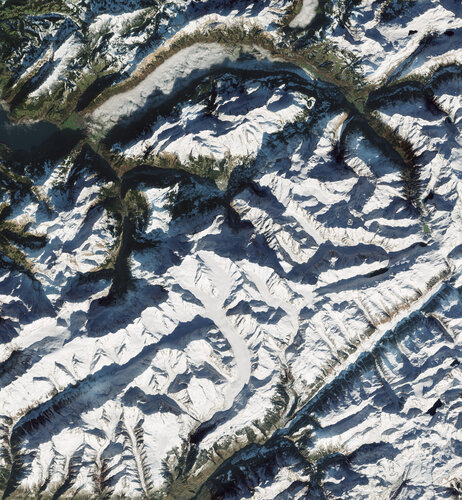The ranges and valleys of the Swiss Alps stand out in this image captured by the Copernicus Sentinel-2 mission in December 2024.
Extending some 1200 km, the Alps occupy an area of about 200 000 sq km and are home to some 20 million people. The image shows the Bernese Alps, which form the central part of the Swiss Alps.
In this image, the sunlight comes from the southeast, illuminating the snow-capped mountains and creating thick shadows over the northern slopes. These shadows across the image may play tricks on the eye, as they can easily be misinterpreted as water bodies.
The largest water body visible in the image is the eastern part of Lake Thun, appearing in dark blue in the top left. Just next to the eastern corner of the lake lies the town of Interlaken, located between lakes Thun and Brienz. Interlaken is partially covered by low-lying clouds trapped in the valley floor, while lake Brienz, to its west, is completely covered.
Near the centre of the image we can see the Aletsch Glacier, the largest in the Alps, which stretches for approximately 23 km and covers an area of around 80 sq km. A typical valley glacier, Aletsch originates in a large, flat area of snow and ice high in the mountains called Concordia, where three smaller glaciers converge. Switzerland’s three famous Eiger, Mönch and Jungfrau mountains rise north of Concordia. The Aletsch Glacier extends south, and its meltwater creates the Massa River in the valley below.
Glaciers in this region are showing long-term retreat from climate change, which poses increased risks such as flooding and landslides to communities.
Aletsch and the surrounding mountains are part of the Jungfrau-Aletsch protected area, a UNESCO World Heritage site, which is home to a wide diversity of ecosystems and is of major importance to scientific research in geology, geomorphology, climatic change, biology and atmospheric physics.



 Image:
The ranges and valleys of the Swiss Alps stand out in this image captured by the Copernicus Sentinel-2 mission in December 2024.
Image:
The ranges and valleys of the Swiss Alps stand out in this image captured by the Copernicus Sentinel-2 mission in December 2024.